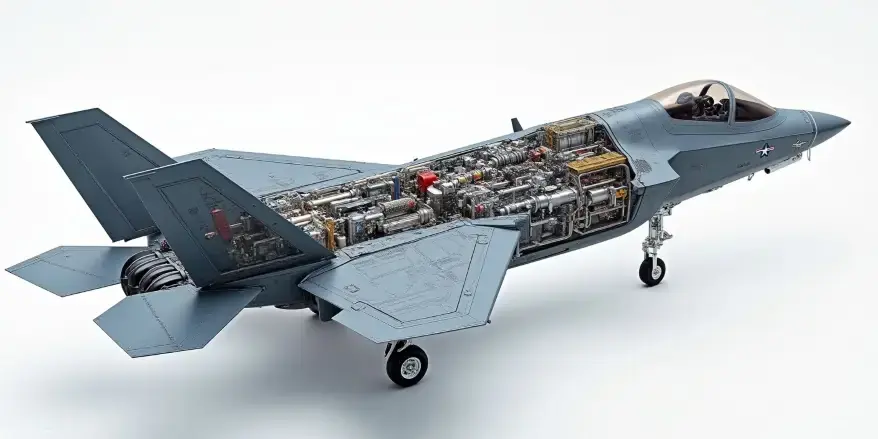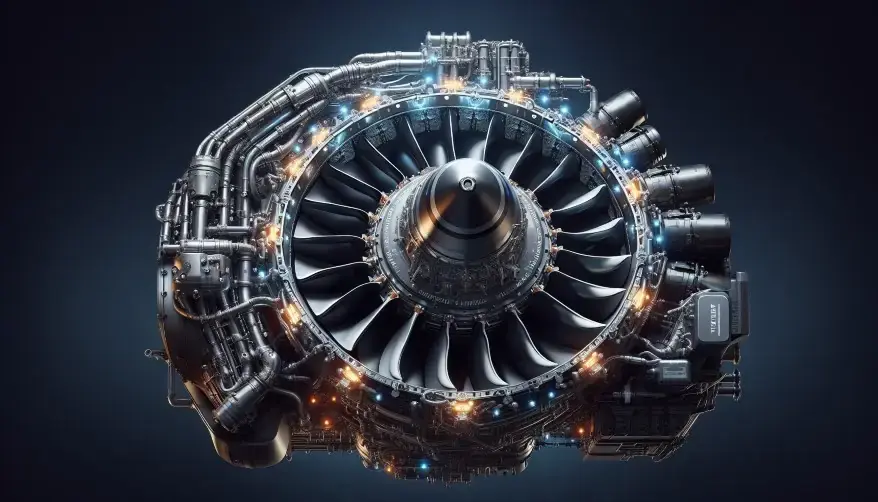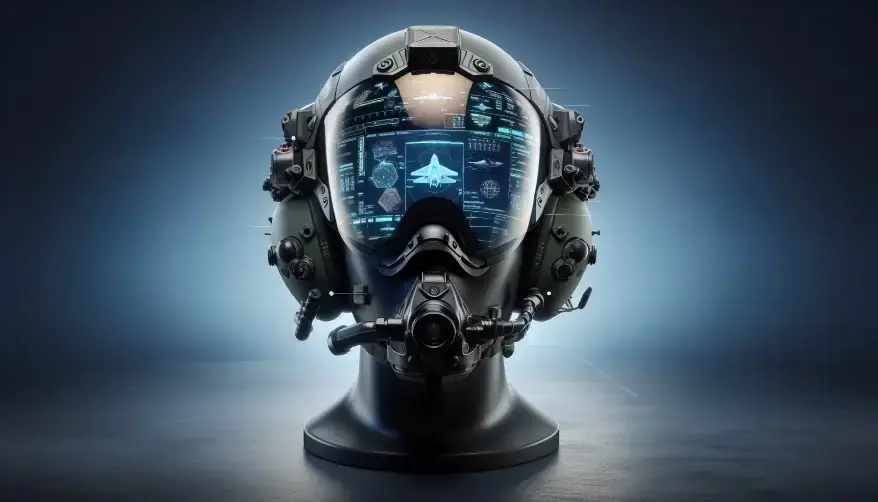The Advanced Systems Powering the F-35 Lightning II in 2025
The F-35 Lightning II represents cutting-edge technology in military aviation. Its technological advancements in 2025 elevate its technological prowess, making it a dominant force in modern air combat. With unmatched air superiority, it performs diverse missions like air-to-ground strikes and reconnaissance. Its three variants—F-35A, F-35B, and F-35C—integrate seamlessly with allied forces, to provide global defense readiness. As former fourth-generation pilots often choose the F-35A in critical scenarios, its reputation as a game-changer grows.
The Evolution of the F-35 Lightning II
Origins and Development
The F-35 Lightning II began its journey in 1995 as part of the Joint Strike Fighter program. Actually, this ambitious project aimed to create a versatile aircraft capable of meeting the needs of multiple military branches. The program reached a major milestone on November 16, 1996, when the development contract was signed. By October 24, 2000, the X-35 prototype took its first flight, showcasing the potential of this groundbreaking design.

Lockheed Martin secured the System Development and Demonstration (SDD) contract on October 26, 2001. Moreover, this marked the start of intensive efforts to refine the aircraft’s capabilities. Manufacturing of the first prototype airframe began in November 2003, and by December 15, 2006, the F-35A variant had its maiden flight. Fast forward to 2021, the program completed operational testing and transitioned to full-rate production. In fact, these milestones highlight the dedication and innovation that brought the F-35 to life.
Transition to Fifth-Generation Fighter
The F-35 evolved into a fifth-generation fighter by integrating cutting-edge technologies and design principles. Its 5th-generation capabilities include advanced stealth, superior performance, and information fusion. These features allow the aircraft to dominate in both offensive and defensive roles. The F-35 also incorporates advanced sustainment systems, ensuring long-term operational readiness.

While it shares some characteristics with the F-22 Raptor, the first operational fifth-generation fighter, the F-35 focuses on versatility. It lacks the super-cruise capability of the Raptor but compensates with its ability to perform a wide range of missions. This balance of innovation and adaptability makes the F-35 a cornerstone of modern air combat.
Continuous Upgrades and Modernization
Modernization has been a constant focus for the F-35 program. The Block 4 upgrade, which began in 2018, introduced an open mission systems architecture. This allows for seamless integration of new technologies. The aircraft now features a next-generation integrated processor with 25 times the computing power of earlier models. An enhanced panoramic cockpit display and expanded memory further improve the pilot’s situational awareness.
The integration of the AN/APG-85 radar enhances target detection and tracking, while the upgraded Pratt & Whitney F135 Engine Core Upgrade (ECU) boosts performance. These advancements aim to improve lethality, survivability, and mission effectiveness. As the F-35 continues to evolve, it remains at the forefront of military aviation technology.
The future belongs to those who prepare for it today. The F-35 program exemplifies this mindset, constantly pushing the boundaries of what is possible in aviation.
Advanced Systems in the F-35 Lightning II (2025)
Next-Generation Engine Technology
The engine of the F-35 Lightning II represents a leap in next-generation technology. The Pratt & Whitney F135 engine powers this next generation fighter jet, delivering unmatched agility and precision. Its technological advancements include an engine core upgrade (ECU) that enhances thrust and fuel efficiency. This improvement ensures the aircraft can operate longer and perform better in high-stakes missions.

The engine also incorporates adaptive cycle technology, which optimizes performance based on mission requirements. This feature allows the F-35 Lightning II to switch between modes for maximum power or fuel efficiency. Such adaptability ensures the aircraft remains versatile in diverse combat scenarios. The engine’s durability and reliability further enhance its operational readiness, making it a cornerstone of the advanced systems powering the F-35.
Sensor and Avionics Upgrades
The sensor suite in the F-35 Lightning II has undergone significant upgrades, enhancing its situational awareness and combat effectiveness. Particularly, the integration of the AN/APG-85 radar replaces the older AN/APG-81, offering improved target detection and tracking. In fact, this radar upgrade ensures pilots can identify threats faster and with greater accuracy.
The aircraft’s advanced sensor package includes the Electro-Optical Targeting System (EOTS) and the Electro-Optical Distributed Aperture System (DAS). These systems provide 360-degree coverage, enabling better target detection and tracking. The DAS, in particular, enhances the pilot’s ability to monitor the battle space, contributing to mission success. The Block 4 upgrade also introduces advanced tactical data links, allowing seamless communication with allied forces. These enhancements ensure the F-35 remains a leader in modern air combat.
Know your enemy and know yourself, and you can fight a hundred battles without disaster — Sun Tzu
The F-35’s fusion of data from its sensor suite embodies this principle, giving pilots a comprehensive understanding of the battlefield.
The F-35 Helmet and Pilot-Centric Innovations
The F-35 helmet is a marvel of engineering, designed to enhance pilot performance and situational awareness. It integrates advanced display technology, providing a clear, 360-degree view of the battle space. Built-in night vision capabilities eliminate the need for separate goggles, streamlining the pilot’s equipment.

The F-35 helmet also features six external cameras that project high-resolution images onto the visor. In fact, this creates a virtual environment, allowing pilots to “see through” the aircraft. Actually, the real-time information on friendly and enemy forces is displayed directly on the visor, aiding quick decision-making. The joint helmet mounted cuing system enables pilots to control weapons systems with precision, further enhancing combat effectiveness.
Particularly, comfort and functionality are key aspects of the F-35 helmet. Two ocular cameras ensure a perfect fit and clear vision for each pilot. Active noise reduction improves communication and focus, while adjustable opacity levels on the visor enhance visibility in various conditions. These innovations make the F-35 helmet an indispensable tool for modern pilots.
Simplicity is the ultimate sophistication – Leonardo da Vinci
The F-35 helmet embodies this philosophy, combining cutting-edge technology with user-friendly design to empower pilots in every mission.
Mission System Integration
When I think about the F-35 Lightning II, one of its most impressive features is its mission system integration. This system acts as the brain of the aircraft, connecting all its advanced technologies into a seamless network. It ensures that every component works together to support the pilot during critical missions.

The mission system integration combines data from multiple sources, such as sensors, radars, and communication systems. Moreover, this integration allows the pilot to receive real-time information about the battlefield. For example, the system can detect enemy aircraft, track their movements, and share this data with allied forces. Undoubtedly, this capability ensures that the F-35 remains a step ahead in every mission.
One of the key benefits of this system is its ability to simplify complex tasks. Indeed, pilots no longer need to switch between multiple screens or systems to gather information. Instead, the mission system integration presents all the necessary data on a single display. This streamlined approach reduces the pilot’s workload and allows them to focus on the mission’s objectives.
Multi Role Capabilities
Another remarkable feature is the system’s ability to adapt to different missions. Whether the F-35 is conducting air-to-air combat, reconnaissance, or ground strikes, the mission system integration adjusts to meet the specific requirements. This flexibility makes the F-35 one of the most versatile aircraft in modern military aviation.
The system also enhances communication between allied forces. It uses advanced data links to share information securely and quickly. This capability ensures that all units involved in a mission have the same understanding of the battlefield. As a result, teams can coordinate their efforts more effectively and achieve their goals with greater precision.
The mission system integration embodies this principle by adapting to the ever-changing demands of modern warfare. It ensures that the F-35 remains a powerful tool for achieving mission success.
In my opinion, the mission system integration is a game-changer. It not only enhances the F-35’s capabilities but also ensures that pilots can perform their missions with confidence and efficiency. This system truly sets the F-35 apart as a leader in military aviation.
Future Upgrades and Combat Implications
Block 4 Software Enhancements
The Block 4 upgrade represents a significant leap forward for the F-35 Lightning II. It introduces over 75 major updates across all variants, ensuring the aircraft stays ahead of emerging threats. These updates enhance the aircraft’s lethality and survivability by improving its ability to recognize and engage targets. For instance, the new AN/APG-85 radar offers better range and precision, while upgrades to the Distributed Aperture System (DAS) and Electro-Optical Targeting System (EOTS) provide superior situational awareness.
The technological advancements in Block 4 also include increased payload capacity and advanced electronic warfare capabilities. These features allow the aircraft to carry more armament and operate effectively in contested environments. Enhanced avionics, powered by an upgraded Integrated Core Processor (ICP), handle data more efficiently, ensuring pilots receive critical information in real time. Additionally, advanced communication systems like MADL and Link 16 enable secure coordination with allied forces, a crucial factor in modern combat.
Artificial Intelligence and Automation
Artificial intelligence (AI) is transforming the way the F-35 operates. By 2025, AI integration will enable the aircraft to act as a control hub for unmanned aerial vehicles (UAVs). This capability allows the F-35 to coordinate drone operations in real time, enhancing operational flexibility. The AI-powered architecture also improves decision-making, enabling the aircraft to adapt quickly to changing combat scenarios.
One of the most exciting aspects of AI integration is its ability to streamline complex tasks. For example, the F-35 can analyze vast amounts of data from its sensors and provide actionable insights to the pilot. This reduces the pilot’s workload and ensures faster, more accurate responses during missions. The collaboration between crewed and other systems, supported by AI, represents a major step forward in the future developments of military aviation.
The F-35’s AI capabilities embody this principle, ensuring it remains a versatile and effective tool in modern warfare.
Enhanced Survivability Features
The future of air combat demands aircraft that can survive in increasingly hostile environments. The F-35’s upgrade program focuses on enhancing its electronic warfare capabilities to counter emerging threats. These improvements allow the aircraft to manage electronic intelligence more effectively, ensuring it can operate in contested environments.
The Block 4 upgrades also equip pilots with tools to dominate the electromagnetic spectrum. Advanced radar and sensor systems, combined with improved cybersecurity measures, protect the aircraft from electronic attacks. In fact, these features not only enhance survivability but also ensure mission success in complex combat scenarios.
The F-35’s enhanced survivability features turn challenges into opportunities, ensuring it remains a formidable force in the future of air combat.
Training and Simulation Advancements
Immersive Pilot Training Systems
I believe that immersive training systems are essential for preparing F-35 pilots to handle real-world combat scenarios. The F-35 Full Mission Simulator offers a fully immersive experience by using software identical to the actual jet. This ensures that pilots can practice in an environment that closely mirrors real missions. Pilots can train for various scenarios, including air-to-ground, air-to-air, and electronic warfare missions. This variety helps them build confidence and adaptability.
The simulator also uses the AMAZE Visual Display System, which employs advanced LED panels. These panels improve reliability and reduce maintenance costs. Unlike traditional projectors, this system minimizes the simulator’s footprint, making it more efficient. High-fidelity simulation allows pilots to transition smoothly from training to actual flight. This seamless transition ensures they are mission-ready from day one.
In fact, these immersive systems help pilots develop the habits they need to excel in the skies.
AI-Driven Training Programs
Artificial intelligence plays a critical role in enhancing pilot readiness. AI-driven training programs provide several benefits that improve both efficiency and effectiveness. For example, predictive analytics enhances mission capability and ensures aircraft readiness. This feature allows pilots to anticipate challenges and prepare accordingly.
| Feature | Benefit |
|---|---|
| Predictive Analytics | Enhances mission capability and aircraft readiness |
| Standardized Training Curriculum | Enables rapid productivity for developers in 4-5 days |
| Collaborative Exercises | Supports operational efficiency for pilots and maintenance crews |
These programs also include a standardized training curriculum, which helps developers become productive in just 4-5 days. Collaborative exercises further improve operational efficiency by fostering teamwork between pilots and maintenance crews. I think these advancements make training more streamlined and effective, ensuring pilots are always prepared for their missions.
Joint Training with Allied Forces
Joint training exercises with allied forces are vital for strengthening global defense strategies. These exercises improve interoperability, allowing F-35 pilots to operate seamlessly alongside allied forces. This capability enhances collective defense and ensures a unified response to threats.
Shared training programs also foster collaboration, improving operational efficiency for both pilots and maintenance crews. Additionally, advanced technology enables rapid response capabilities, ensuring faster deployment during emergencies. These benefits make joint training an indispensable part of F-35 pilot preparation.
The F-35’s Role in Modern Air Combat
Multirole Capabilities
The F-35 Lightning II excels as a multirole combat aircraft. I find its ability to perform diverse missions remarkable. It dominates in air superiority, ground attack, and reconnaissance roles. Its advanced stealth technology allows it to evade enemy radar, ensuring mission success even in heavily defended areas. Additionally, the aircraft’s integrated sensors and data-sharing capabilities provide pilots with unmatched situational awareness. This makes it a critical asset in modern network-centric warfare.
What impresses me most is how the F-35 adapts to different combat scenarios. For instance, during air-to-ground missions, it can deliver precision strikes with minimal collateral damage. In air-to-air combat, it outmaneuvers adversaries with its agility and advanced targeting systems. Its reconnaissance capabilities also stand out, as it gathers and shares real-time intelligence with allied forces. This versatility ensures the F-35 remains indispensable in any combat environment.
Strategic Importance in Global Defense
The F-35 plays a pivotal role in strengthening global defense strategies. Undoubtedly, its presence enhances air combat readiness by integrating seamlessly with existing military assets. I believe this interoperability is crucial for joint operations with allied forces. Shared training programs ensure pilots and maintenance crews understand the F-35’s systems thoroughly, improving operational efficiency.
The F-35 promotes interoperability, enabling allied forces to operate together effectively.
It enhances regional stability by serving as a deterrent against potential aggressors.
Its advanced capabilities compel adversaries to rethink their military strategies.
I see the F-35 as more than just an aircraft. Particularly, it represents a united front among allied nations, ensuring peace and stability in an unpredictable world.
Preparing for Future Threats
The F-35 prepares for future threats by staying ahead of technological advancements. Its adaptability ensures it can counter emerging challenges effectively. For example, its electronic warfare systems protect it from cyber and electromagnetic attacks. These features make it resilient in contested environments.
The aircraft’s ability to integrate artificial intelligence enhances its combat effectiveness. AI streamlines decision-making, allowing pilots to respond quickly to dynamic situations. Additionally, the F-35’s open mission systems architecture enables seamless upgrades. In fact, this ensures it remains relevant as new threats emerge.
The F-35 embraces this moment by preparing for the challenges of tomorrow.
The F-35 Lightning II continues to redefine modern aviation. Its advancements in 2025 showcase how far cutting-edge technology can take us. I see it as more than just an aircraft; it’s a symbol of innovation and adaptability. Its ability to evolve ensures it remains unmatched in combat performance and survivability. As a cornerstone of global defense, it prepares for future challenges while maintaining its superiority.
The value of an idea lies in the using of it – Thomas Edison
The F-35 exemplifies this by turning ideas into unmatched capabilities.
FAQ
What makes the F-35 a fifth-generation fighter?
The F-35 Lightning II combines stealth, advanced sensors, and information fusion to dominate in combat. Moreover, its ability to perform multiple roles, from air-to-air combat to reconnaissance, sets it apart. Additionally, these features ensure it meets the demands of modern warfare.
How does the F-35’s stealth technology work?
The F-35 uses special materials and design to reduce its radar signature. Its shape deflects radar waves, while its coatings absorb them. This makes it harder for enemies to detect, giving pilots a significant advantage in combat.
What is the purpose of the Block 4 upgrade?
The Block 4 upgrade improves the F-35’s lethality, survivability, and situational awareness. It adds new software, sensors, and weapons capabilities. Indeed, these updates ensure the aircraft stays ahead of emerging threats and remains effective in future combat scenarios.
How does artificial intelligence enhance the F-35?
AI helps the F-35 process vast amounts of data quickly. It assists pilots by providing actionable insights and automating complex tasks. In fact, AI also enables the F-35 to coordinate with drones, making missions more efficient and flexible to changing conditions.
Why is the F-35 helmet so advanced?
The F-35 helmet provides pilots with a 360-degree view of their surroundings. Also, It integrates night vision, external cameras, and real-time data displays. Specifically, this technology improves situational awareness and allows pilots to make faster, more informed decisions during missions.
How does the F-35 support allied forces?
The F-35 promotes interoperability by sharing data with allied forces in real time. In fact, its advanced communication systems enable seamless coordination during joint missions. Also, this strengthens global defense strategies and ensures a unified response to threats.
What training systems prepare pilots for the F-35?
Pilots train using the F-35 Full Mission Simulator, which replicates real-world scenarios. AI-driven programs and joint exercises with allies enhance readiness. Additionally, these systems ensure pilots are well-prepared for the challenges of modern air combat.
How does the F-35 adapt to future threats?
The F-35 features an open mission systems architecture, allowing for easy upgrades. Its electronic warfare systems protect against cyber and electromagnetic attacks. Indeed, these capabilities ensure the aircraft remains effective as new threats emerge.
References
- F-35A 6 ship. (n.d.). Lockheed Martin. https://www.lockheedmartin.com/en-us/products/f-35.html
- Geng, Z., Wang, B., Yan, H., Zhang, J., & Zhu, D. (2021). Moving target detection and tracking with multiplatform radar network (MRN). IET Radar Sonar & Navigation, 16(5), 815–824. https://doi.org/10.1049/rsn2.12222
- Lőrincz, E., et al. (2023). Optical system of page organized optical storage device. Conference on Lasers and Electro-Optics-Europe, CWF60. https://doi.org/10.1364/cleo_europe.1998.cwf60
- Ma, Y. (2023). Target tracking and detection based on yolov5 algorithm. Applied and Computational Engineering, 16(1), 75-85. https://doi.org/10.54254/2755-2721/16/20230860
- Maathuis, C. (2022). On explainable AI solutions for targeting in cyber military operations. International Conference on Cyber Warfare and Security, 17(1), 166-175. https://doi.org/10.34190/iccws.17.1.38






